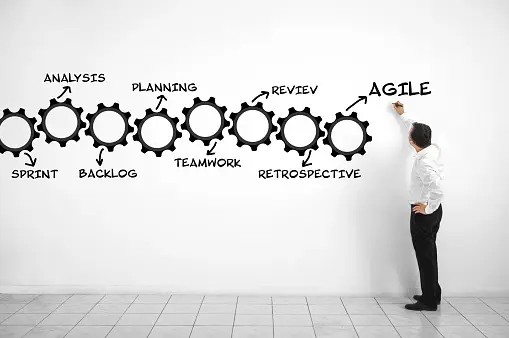If you manage projects, you must have faced the challenge of meeting deadlines, budgets and keeping the team motivated. Perhaps the new Scrum business model can facilitate the implementation of planned activities.
The term Scrum or agile business refers to a business model that is based on self-organizing, cross-functional teams, focused on achieving results. The term Scrum comes from rugby and implies a formation in which 8 players are positioned in 3 rows who together try to win the thrown ball, before the opposing side. It is a symbol of unity, focus and a clear goal.
In the 80s, Jeff Sutherland and Ken Swaber developed the Scrum business model (the most famous Agile set of values and principles) that was adopted by a large number of software companies around the world. Of course, other industries (manufacturing, finance, insurance, telecommunications…) noticed the advantages of this way of organizing after some time and began to introduce the Scrum business model en masse.
Traditional vs. Scrum project management
Traditionally, management wants two things in every project: control and predictability. This implies a large number of documents, diagrams, approvals. Months are invested in careful planning, but the effort is often in vain, as corrections turn out to be inevitable. In the conditions of rapid and unpredictable changes, project management generally leads to fiasco or, in the best case, to prolongation of deadlines and increase of costs. Of course, those who ordered the work are frustrated, and the executors are dissatisfied. And does it have to be like that? Actually, it doesn’t have to.
Many companies accept the new concept of Scrum and the agile way of doing business as a salvation, because if properly implemented, it enables a more efficient organization of work.
Scrum embraces uncertainty and creativity. When a project is started, it is regularly checked whether what is being done is going in the right direction and constantly looking for ways to improve – whether there is a faster and better technique and whether there are obstacles to realizing it. It is the “inspect and adopt” circle. The verification is carried out in iterations, and the sequential goals must be fulfilled (added value, or increment) for a fixed time (usually 2-4 weeks).
The elimination of obstacles must be the first goal of business
There are many factors that influence the success of a company’s transition towards doing business according to the Scrum model, but the main one is changing the “mindset”. The fact that many companies (some of them even very famous, such as Google, Amazon…) have very successfully implemented this way of working, thinking and planning is encouraging. Toyota is credited with many of the ideas on which Scrum is based, which have been implemented in the Toyota Production System. The most famous of them refers to the elimination of obstacles. Namely, the development process should run quickly and smoothly, and one of the key tasks of the management is to identify and remove all obstacles in its course, the so-called. flow. Everything that stands in the way, everything that stands in the way is an obstacle. They have identified different types of obstacles in the Toyota production system and believe that it is not an exaggeration to say that in a period of slow growth obstacles represent a bigger problem than business loss. Hence, the elimination of obstacles must be the first goal of business.
It is important to determine what brings the most value to the product
Another question is very important to define correctly when getting a project – what brings the most value to the product? If the answer is clear and relevant, the teams working on the realization will drastically improve their productivity. Oftentimes, employers say that everything is important, but this is really not true. From experience, 80% of a product’s value lies in 20% of its functionality. We will cite an example that is familiar to everyone and refers to a program that we use every day at work: How much functionality do you use in Word documents? Do you know what all the functionalities are and are they necessary for most users? The answer, of course, is no – most use several basic functions. In accordance with this way of thinking, many manufacturing companies, in the desire to place a new product on the market as soon as possible, apply the concept of MVP (Minimum Viable Product). Given that a large number of innovations do not reach their first anniversary, the idea is to launch a product that has enough basic functionality that means something to customers, like a test, and if it proves successful, in the next iterations the product/recipe is improved and so on. Therefore, the secret of success is to find priorities according to values and to do the most important 20% first in each project.
How a Scrum Team Works
The strength of a team that functions according to Scrum principles lies in how well they cooperate with each other and how much each team member contributes to the achievement of the goal according to his expertise and role in the organization. New positions and roles in a company operating in Scrum or agile way are Scrum Master and Product Owner (currently “top-in-demand” globally). Companies that have embarked on an agile transformation, ug they usually send their employees to certified trainings in order to improve their knowledge and later have the opportunity to apply what they have learned in practice.
Scrum Master is not an IT position, but a person who “knows with people”, i.e. has “people skills” and emotional intelligence and influences a good atmosphere in the team, helps team members through coaching and has the responsibility to finish the project as soon as possible, and the most important thing is that implements an agile or Scrum mindset throughout the organization.
The Product Owner is the person who needs to understand the needs and wants of the “customer”, to convey the vision to the team members, set priorities and organize an agile team that needs to deliver value. His role is to start a business and to make important decisions, even to take risks.
Agile teams work differently
Agile teams work differently from traditionally organized teams and are highly dependent on effective and efficient communication and rapid execution. The team should have good discipline, ability to take responsibility (agile leadership role) and be committed. Team members should have the freedom to ask for help and seek revision as needed. Thus, the key skills are the ability to take initiative and adapt to new situations.
“We practice improvement through work, work through improvement, one sprint at a time!” Jon Kerr.
Scrum values
Commitment – Commitment for the Scrum team means that each member of the team has confidence in others, that is, confidence that others will do what they said. It is important not to overestimate the capacity, that is, to accept only tasks that can be fulfilled.
Courage – Courage is key to team success. The Scrum Team must feel safe and secure to say no, ask for help, or experiment with new things. Also, he should have the freedom to question the status quo that is an obstacle to success.
Focus – Focus is important in the sense that whatever is started, should be completed during the “sprint” or within the stipulated time. That is why the status is regularly monitored through the burndown chart.
Openness – Openness is essential for finding new ideas and the opportunity to learn and grow. Additionally, openness means that team members must be honest in order to know the status.
Respect – Respect should be shown to other team members, as well as to the Product Owner, Scrum Master and all other stakeholders. Other people’s ideas are respected, achievements are recognized and a “bad day” is tolerated sometimes.
Ultimately, for any agile project to be successful and productive, the team needs to demonstrate more enthusiasm and the ability to learn from all contributors, regardless of their seniority and expertise. Fearless expression of opinion must be ensured, in order to show genuine respect, which in turn will increase the team’s focus on goals.

